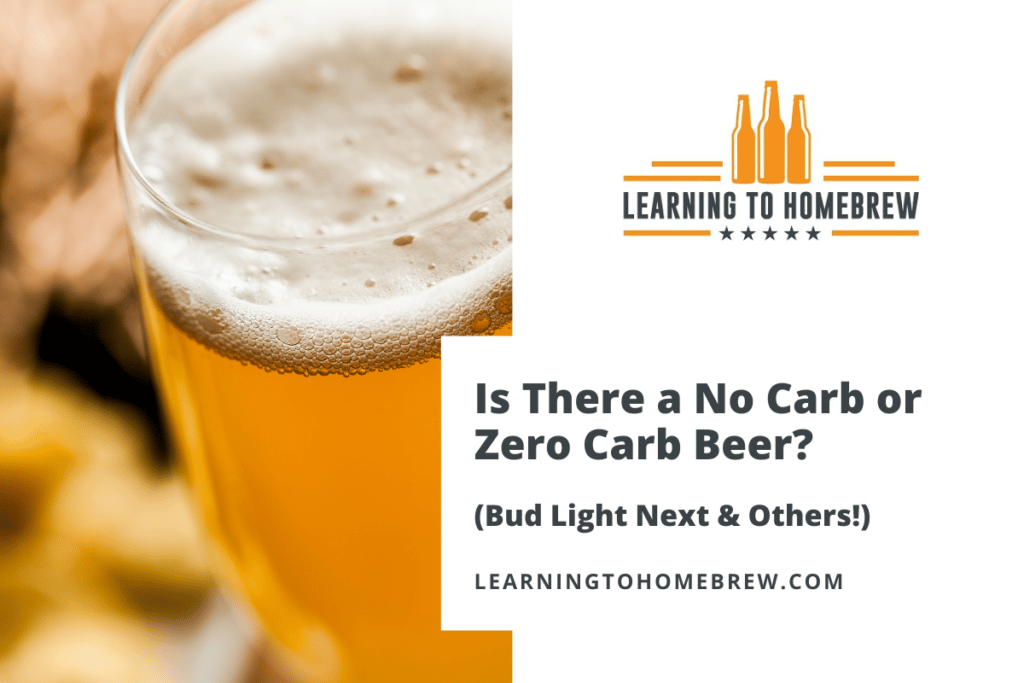A Schwarzbier is one of those styles that makes you do a double take the first time you try it. It looks like a Stout but doesn’t have as heavy of a flavor profile. To brew this contradicting beer, it is important to approach it with skill and knowledge.
Brew a delectable Schwarzbier with neutral water with a balance between chlorides and sulfates. Start with Pilsner, Munich, or both for the base grains. Add complexity with chocolate, crystal, and Carafa specialty grains. Use German noble hops with a highly attenuating yeast that flocculates well and produces no esters.
A Schwarzbier is not as complicated as some beer styles but it does require a few specialty techniques. Keep reading for the ingredients, process, and some basic recipes.
Topics We Cover
What is a Schwarzbier?
A Schwarzbier is a dark, well-balanced, German lager.
It has a light malt aroma with roasted malt flavors. Balancing the malt flavors is light hop characteristics–usually floral, herbal, or spicy. These flavors come together to make a smooth flavorful beer.
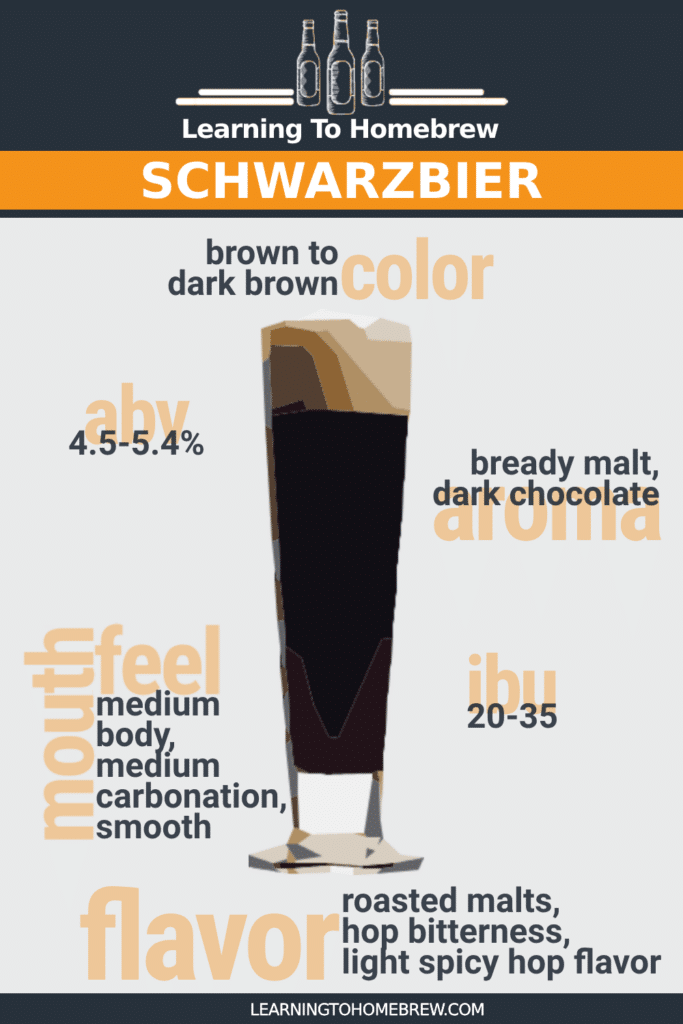
Defining characteristics of Schwarzbiers include:
- Color – 19-30 SRM (brown to dark brown)
- Common flavor – Roasted malts, hop bitterness, light spicy hop flavor
- Aroma – Bready malt, dark chocolate
- Mouthfeel – Medium body, medium carbonation, smooth
- IBUs (Bitterness) – 20-35
- ABV – 4.4-5.4%
The aroma won’t have any strong malt character, just hints of roast and rich bread. The hop aromas of this style should be present in the nose to a similar strength. The majority of this beer’s character is in the flavors.
This style boasts more flavor than your average lager. As a dark lager, it has roasted malt flavors but doesn’t tip over into burnt flavors. The roast should be smooth yet forward. Overall, this style is most often dry but can be slightly sweet.
In appearance, a Schwarzbier is quite dark. The style ranges from medium brown to dark brown.
Did you know? Schwarzbier means “black beer.” However, most examples won’t reach a true black. Instead, it should be a rather clear beer with dark red highlights.
History of the Schwarzbier
Schwarzbier has one of the longest histories in the beer world. The oldest confirmed mention of the style was at the end of the 14th century but historical evidence suggests the style may have origins as far back as 800 BC.
The exact date of the earliest recorded mention of Schwarzbier is 1390. Brewers in Braunschweig (Brunswick), Germany brewed a black beer called Braunschweiger Mumme which was an early version of the style.
It is, however, highly likely that the style or early variations existed before the 1300s but all direct references have been lost to time. One possible link to the style was discovered near Kulmbach, Germany.
Archaeologists discovered remnants of a black beer in a tomb devoted to an important Celt. This, along with some bread, indicates that brewers of that time were brewing a similar dark beer. Over time, this may have developed into an early Schwarzbier.
Popular commercial Schwarzbiers
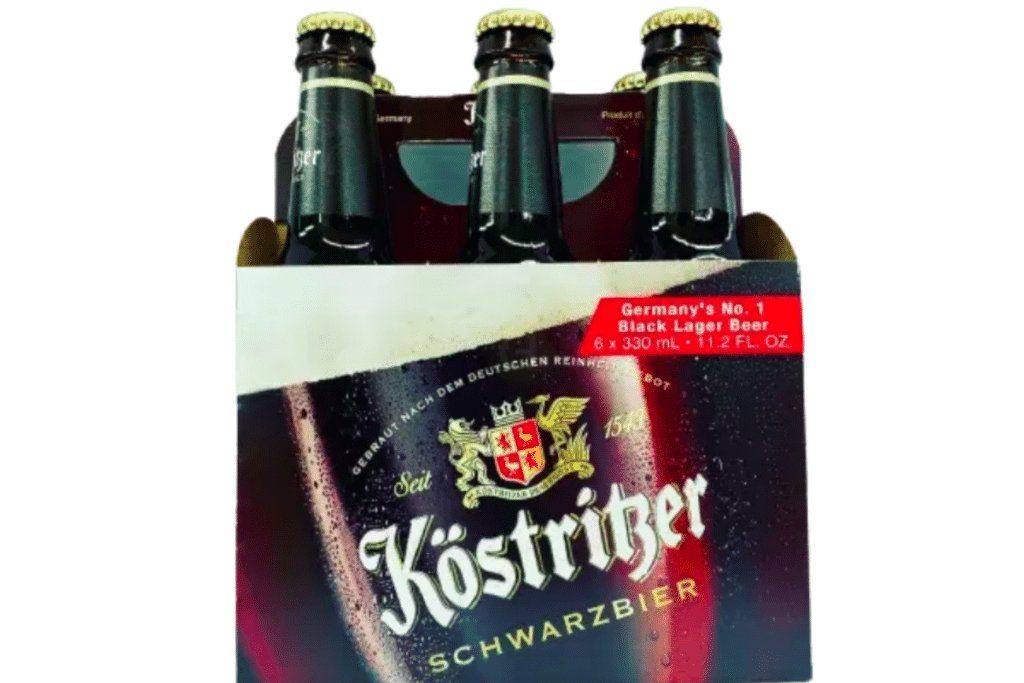
For the beer enthusiasts and the beer curious here’s a quick list of Schwarzbiers you should try:
- Köstritzer Schwarzbier – A classic example of the style. This Schwarzbier is brewed with quality roasted barley that provides a uniquely smooth experience.
- Chuckanut Schwarz Lager – This Schwarzbier provides a crisp, refreshing experience with great flavors. It is lightly bitter, has great roast flavor, and finishes dry.
- Kulmbacher Brauerei Mönchshof Schwarzbier – A light example of the Schwarzbier style. The Mönchshof Schwarzbier is roasty, dry, and slightly bitter.
- Uinta Brewing Company Baba Black Lager – Another great Schwarzbier, the Baba Black Lager leans into the roast character with notes of dark chocolate and wood smoke. The malt character is balanced by 38 IBUs of bitterness.
If you love German beers, check out this list of the top 9 beers to try this Oktoberfest, then try brewing one for yourself!
How to brew a Schwarzbier
Once you’ve explored some great examples of a Schwarzbier, you may be considering brewing your own. In order to brew the best beer, you need to know the style forward and backward. To that end, I will break down everything you need to know.
As with most German-style beers, you’ll want to start with neutral water with a balance between chlorides and sulfates. Pilsner or Munich hops (or both) are the traditional choice for your base grain, then add complexity with chocolate, crystal, and Carafa specialty grains. Use a highly attenuating yeast that flocculates well and produces no esters.
Let’s start by going over some great choices for the recipe and ingredients. Then, we can look at the process including brew day, fermentation, and bottling.
Recipe and ingredients
While you can’t have beer without fermentation, you can’t get anywhere without quality ingredients. There are of course no wrong ingredients, but some will go together much better than others.
The recipes for this style typically use the same ingredients with some variation here and there:
- Water profile
- Base grains
- Specialty grains – especially rice or corn
- Hops
- Yeast
As always, start with your water. Since beer is nearly 90% water, good water makes good beer. Then consider your grain bill, hops, and finally yeast. Each one can have a significant impact on your final product.
Water profile
As this style is a lager rather than a porter or stout, you don’t want to shoot for a water profile that will enhance any specific flavor. To this end, keep your chlorides and sulfates balanced.
The best water profile for a Schwarzbier is fairly neutral with a balanced sulfate-to-chloride ratio. Depending on how you handle the darker grains you may need to adjust for the pH drop.
If you use a lot of dark grains in your grain bill, you will have to raise the alkalinity of your water profile to ensure the mash pH doesn’t drop too low. Baking soda is a great way to do this.
Alternatively, you can add these grains during the Vorlauf stage to get some of the roasted character without the full pH drop. However, this may require you to add some acid so that the mash pH goes low enough.
Related: Can You Use Tap Water for Homebrew? (Pros, Cons, & Watch Outs!)
Base grains
The best base grains for a Schwarzbier are Munich and Pilsner malts. These malts provide a great starting canvas of grainy flavors.
When it comes to the Munich malts you’ll want to generally go with the lighter varieties, although you can use a little of the darker Munich malts. Either light or dark Munich will add some nice grain flavors and some toast in the case of the darker variation.
The Pilsner malt will be more subdued than the Munich malts. It will add some light, crisp malt flavors. This makes a great backdrop for the specialty malts to add the main flavors.
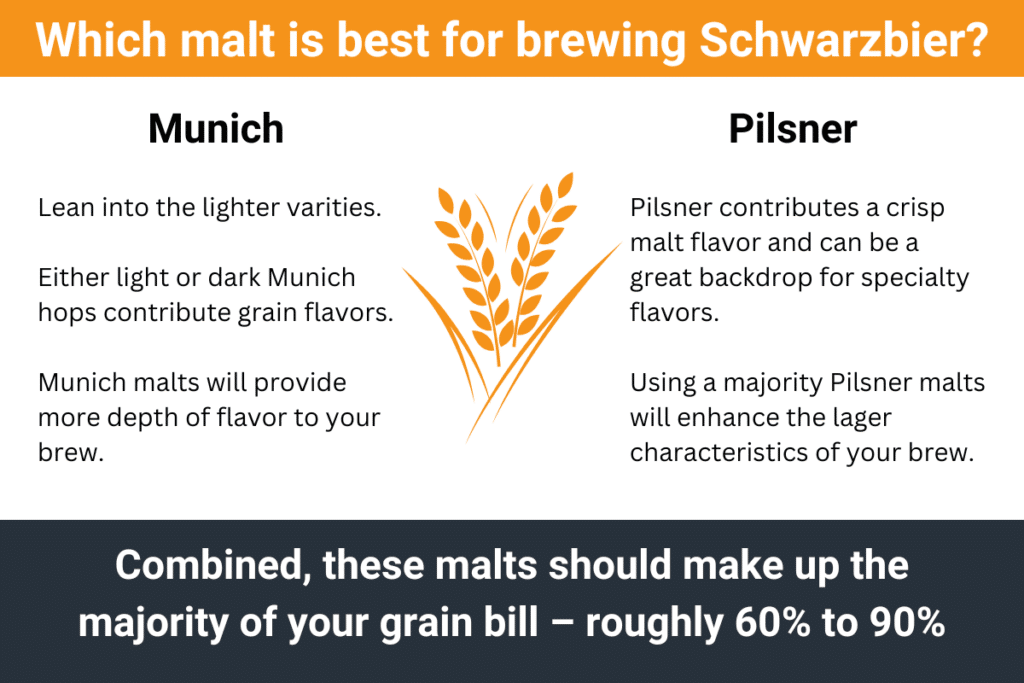
These malts should make up the majority of your grain bill – roughly 60% to 90%. The leading base grain is dependent on personal taste. A Munich malt lean provides more depth of malt flavors while a Pilsner malt lean enhances the lager characteristics.
Specialty grains or other additions
Specialty grains should be used sparingly when brewing Schwarzbier to add some of the flavors and aromas of dark malts without adding too much bitterness or burnt flavors.
The best specialty grains to include in a Schwarzbier are Caramel, Chocolate, or Carafa malts. These specialty grains should not make up more than 20% of your grain bill.
Light to medium color caramel malts are the style you should go with in this beer. These will add some light caramel flavors and hints of toast.
Chocolate and Carafa malt in particular should be used very lightly – in the range of 0% to 5%. Chocolate malts can add some great chocolate notes and some roasted flavors. Carafa adds similar flavors but as it is dehusked it does not add as much bitterness.
The most important contribution these malts bring aside from the flavors is the color that gives this style its name. Add just enough to achieve a dark SRM without dipping into Porter and Stout territory.
Hops
A Schwarzbier calls for moderate hop additions for both bittering and flavor.
German noble hops are the best choice for both. Alternatively, pick hop varieties with similar characteristics.
What’s important for hopping a Schwarzbier is that it balances the malt flavors. Adjust your hop additions within the IBU range to complement the malts you’ve chosen.
Bittering
Bittering hops added early in the boil will go through a process called isomerization. This is what gives a beer its bitterness.
A Schwarzbier calls for anywhere from 20 to 35 IBUs. For convenience, use higher alpha acid concentration varieties for bittering.
Here are some good choices for bittering hops.
| Name | Purpose | Alpha Acid % |
|---|---|---|
| Saaz | Flavor + Aroma | 2.5-4.5% |
| Hallertau | Flavor + Aroma | 3.5-3.5% |
| Tettnang | Flavor + Aroma | 2.5-5.5% |
| Magnum | Bittering | 12-14% |
Aroma and flavor
Aroma and flavor hops added towards the end of the boil don’t add much bitterness. Instead, they add oils that provide flavor and aroma.
A Schwarzbier calls for some hop flavor and light hop aroma.
Here are a few good choices to get you started.
| Name | Flavor/Aroma | Alpha Acid % |
|---|---|---|
| Saaz | Woody, floral, citrus, cream | 2.5-4.5% |
| Hallertau | Herbal, woody, floral | 3.5-3.5% |
| Tettnang | Woody, floral, citrus, cream | 2.5-5.5% |
| Liberty | Floral, spicy | 3-5% |
Yeast
A Schwarzbier calls for a yeast strain that has medium attenuation, medium to high flocculation, and no ester production. The best yeast strains are neutral and clean.
You want a yeast that leaves the beer fairly dry without much haze and no off-flavors. The yeast should not impact the flavor profile of the beer much overall.
Dry
Below are some good dry yeast options for a Schwarzbier.
| Name | Attenuation | Flocculation | Temperature Range |
|---|---|---|---|
| SafLager W-34/70 | 80-84% | High | 53-65°F |
| Mangrove Jack’s M84 | 72-76% | High | 50-59°F |
| LalBrew Diamond | High | High | 50-59°F |
Liquid
Below are some good liquid yeast options for a Schwarzbier.
| Name | Attenuation | Flocculation | Temperature Range |
|---|---|---|---|
| Wyeast 2124 | 73-77% | Low to Medium | 45-68°F |
| WLP830 | 74-79% | Medium | 50-55°F |
| Wyeast 2206 | 73-77% | Medium to High | 46-58°F |
Brewing process
After acquiring all of your ingredients you can move on to brew day. What you do on brew day can have just as much impact on your results as your choices of ingredients. On brew day, one of the most important aspects is sanitization. Be thorough when sanitizing.
All-grain, partial, and extract brewing each have important considerations for you to make. When doing all-grain or partial brewing, you need to consider mashing and sparging. From there the other considerations are similar. The boil step and on is the same for all three.
Let’s break down each step with the Schwarzbier in mind.
Mashing
A single infusion mash will be perfectly fine for this style. An hour-long mash is all you’ll need.
For a Schwarzbier, your mash temperature should be between 150°F and 154°F. This range will create a drier beer with the help of the yeast. This beer does not need a more involved step mash but it can help with specific control over the result.
As mentioned above, you can wait to add your dark malts until the Vorlauf stage of lautering. This can reduce the astringency added in addition to reducing the pH drop. That said, if you only use a little of these specialty grains and raise the alkalinity of your water appropriately you won’t need to do so.
Boil
The boil for a Schwarzbier should be an hour long. Hop additions will be towards the beginning and end.
The hop addition times are heavily dependent on the amount, alpha acid concentration, and purpose. Since this style calls for a balance between the flavors, aromas, and bitterness you will have a few additions at the beginning for bitterness and a few towards the end for flavor.
Whirlpool or flameout
Boil aside, there are other times to add hops. They aren’t strictly necessary but can be great for adding flavor and aroma.
Adding hops during flameout can be a great way to get the flavors and almost no bitterness. This is done directly after the boil and before you pitch yeast. As you transfer to your fermentor create a whirlpool as you drain the boiling vessel. A flameout addition may be useful in a Schwarzbier.
This is only possible when you have a vessel that can drain from the bottom. Whirlpooling can also be a great way to collect the trub in the middle and reduce the amount that gets in your fermentor.
If you want to lean into the hop characteristics this is a great option. It is, however, not necessary.
Fermentation
As always, fermentation is crucial but mostly hands-off.
Keeping the fermentation temperature consistent aside from deliberate step-ups is crucial for quality beer. Be sure to avoid direct sunlight and keep the temps in the mid-range for a Schwarzbier. A diacetyl rest is recommended for this style.
Keeping the fermentation at a consistent temperature will help keep your brew clean from any fermentation byproducts. At lower temperatures, you will avoid ester production if you happen to be using a yeast strain with some ester production.
After the diacetyl rest, it is helpful to lager a Schwarzbier for at least a couple of weeks to a month. This can help clarify the beer and promote a crisp character.
Temperatures
While the temperatures are yeast dependent, there is a rough range you should keep your Schwarzbier near.
Try to keep your fermentor around 50-55°F for the majority of the process. Increase the temperatures to 65-68°F for the last two days to perform a diacetyl rest.
If you miss your temp goals by a few degrees or can’t keep the temperature consistent, it won’t be the end of the world. This level of micromanaging is great for elevating your final product but isn’t always essential.
Some homebrewers like to start fermentation below 50°F and slowly warm up to the 50°F to 55°F range. This is meant to help reduce diacetyl.
Lagering should be at nearly freezing temperatures. Anywhere from 32°F to 38°F will do well.
Bottling or kegging
The debate between bottling and kegging will go on for as long as brewers have a choice. It is truly up to personal preference and setup.
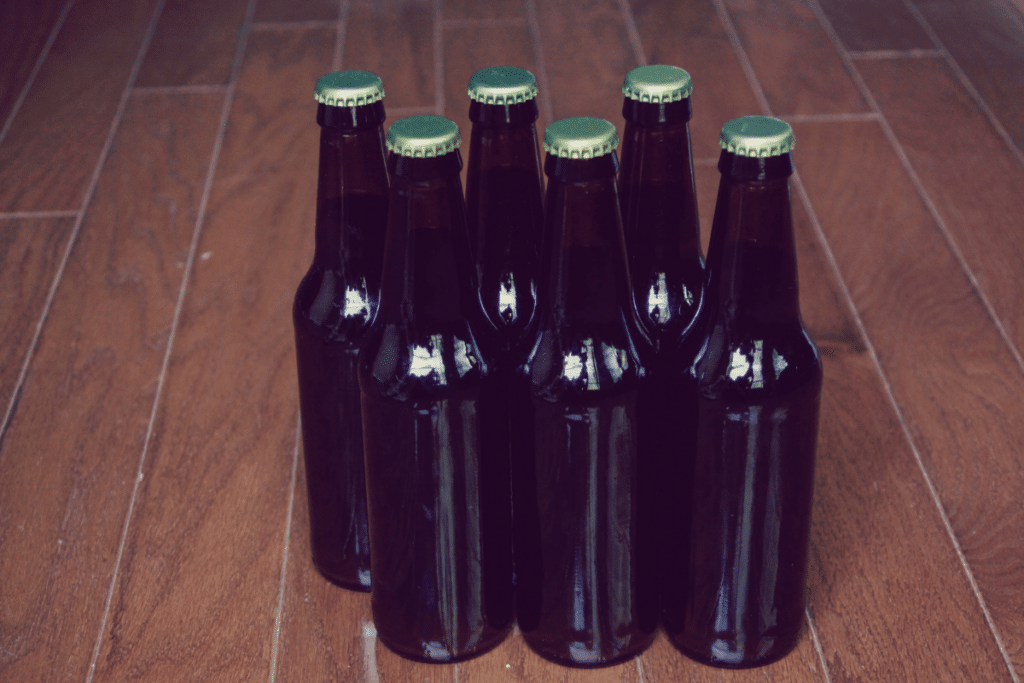
There is little preference between bottling and kegging for Schwarzbiers. Kegging will allow you to bulk condition while bottles can make it easier to save portions for aging.
Choose the method that is easiest for you.
Schwarzbier recipes
If you aren’t one to create your own recipes here are a few that you can follow for great results. These recipes are from various brewers as credited below.
- 08B1. Schwarzbier (All Grain)
- Schwartzbier von Köstritz (All Grain)
- Schwarzbier (Extract)
08B1. Schwarzbier (All Grain)
This recipe comes from user WAWooldridge on Brewer’s Friend.
Ingredients
- German Dark Munich – 7 lb
- UK Maris Otter Pale – 8 lb
- UK Crystal 45° L – 0.5 lb
- UK Pale Chocolate – 0.5 lb
- German Carafa II – 0.25 lb
- German Pilsner – 1 lb
- Magnum hops – 0.5 oz
- Hallertau Mittelfruh – 1 oz
- Irish Moss – 1 tsp
- Chalk – 16 g
- Epsom salt – 2.5 g
- Phosphoric acid – 75.04 ml
- Wyeast 2124
Method
- Heat 9.7 gallons to 131°F.
- Add grain bill except for the Pale Chocolate and Carafa malts. Rest for 90 minutes.
- At 1 hour left, add the chalk, Epsom salt, and 68.46 ml of the phosphoric acid.
- Increase temperature to 145°F and rest for 15 minutes.
- Increase temperature to 158°F and rest for 15 minutes.
- Increase temperature to 170°F and rest for 20 minutes.
- Mashout. As you sparge, add the rest of the phosphoric acid.
- During the Vorlauf stage, add the Pale Chocolate and the Carafa.
- Collect 7.5 gallons of wort.
- Boil for 60 minutes. Add the Magnum at the beginning.
- At 15 minutes left, add the Irish moss.
- At 5 minutes left add the Hallertau Mittlefruh.
- Flameout and transfer to the fermentor.
- Cool and pitch yeast.
- Maintain 52°F during fermentation.
- Perform a diacetyl rest at 65°F.
- Rack to keg or bottles after a week or two of primary. Lager for at least 3 weeks to a month. Enjoy!
Schwartzbier von Köstritz (All Grain)
This recipe comes from user Brewer #62905 on Brewer’s Friend.
Ingredients
- German Pilsner – 8 lb
- German Dark Munich – 3 lb
- Sinamar – 5 oz
- Tradition hops – 0.9 oz
- Saaz hops – 1.8 oz
- Wyeast 2124
Method
- Heat 4.25 gallons to 130°F.
- Add grain bill except for the Sinamar and rest for 20 minutes.
- Increase the temperature to 150°F and rest for 1 hour.
- Increase the temperature to 170°F and rest for 5 minutes.
- Mashout.
- Collect 8 gallons of wort. Add the Tradition hops to the boil kettle before the wort.
- Boil for 90 minutes.
- At 15 minutes left add half of the Saaz.
- Flameout and add the rest of the Saaz. Then transfer to the fermentor.
- Cool and pitch yeast.
- Maintain 58°F during fermentation.
- Perform a diacetyl rest at 65°F.
- After fermentation, rack to keg or bottles. Lager for a few weeks to a month. Enjoy!
Schwarzbier (Extract)
This recipe comes from user peterj on Brewer’s Friend.
Ingredients
- LME Munich – 7 lb
- German Carafa III – 0.5 lb
- UK Pale Chocolate – 0.5 lb
- UK Crystal 60° L – 0.38 lb
- Magnum hops – 0.5 oz
- Hallertau Mittlefruh – 1 oz
- Saflager W-34/70
Method
- Heat 5.5 gallons of water for your boil.
- Add the steeping grains when the water is around 140°F.
- Steep for roughly 20 minutes.
- Remove the grains when the water is around 170°F.
- When a boil is reached, add the malt extract.
- Boil for 60 minutes. Add the Magnum hops right away.
- At 10 minutes left, add the Hallertau Mittlefruh.
- Flameout and transfer to the fermentor.
- Cool and pitch yeast.
- Maintain 55°F during fermentation.
- Perform a diacetyl rest at 65°F.
- After a week or so on primary, rack to keg and force carbonate or bottle condition. Lager for at least a few weeks to a month.



